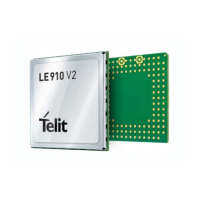Telit LE910 V2 Series AT Commands
80446ST10707A Rev. 0– 2015-11-03
Reproduction forbidden without Telit Communications S.p.A. written authorization - All Rights Reserved page 217 of 509
Mod. 0808 2011-07 Rev.2
#MONI: Adj Cell<n> [LAC:<lac> Id:<id>] ARFCN:<arfcn>
PWR:<dBm> dBm
(UMTS network)
#MONI: PSC:<psc> RSCP:<rscp> EcIo:<ecio> UARFCN:<uarfcn>
SCR:<scr>
where:
<netname> - name of network operator
<cc> - country code
<nc> - network operator code
<n> - progressive number of adjacent cell
<bsic> - base station identification code
<qual> - quality of reception
0..7
<lac> - localization area code
<id> - cell identifier
<arfcn> - assigned radio channel
<dBm> - received signal strength in dBm; for serving cell in UMTS network
this is not available during a call, and is displayed as 0
<timadv> - timing advance
<psc> - Primary Scrambling Code
<rscp> - Received Signal Code Power in dBm; for serving cell this is not
available during a call, and is displayed as 255
<ecio> - chip energy per total wideband power in dBm; for serving cell this is
not available during a call, and is displayed as 255
<uarfcn> - UMTS assigned radio channel
<drx> - Discontinuous reception cycle length
<scr> - Scrambling code
Note: TA: <timadv> is reported only for the serving cell.
4. If the last setting done by #MONI is 7, the execution command produces a
table-like formatted output, as follows:
(GSM network)
a. First row reports the identifying name of the ‘columns’
#MONI:
Cell BSIC LAC CellId ARFCN Power C1 C2 TA RxQual PL
MN<CR><LF>
b. Second row reports a complete set of GSM-related information for the
serving cell:
#MONI:
S: <bsic> <lac> <id> <arfcn> <dBm> <C1value> <C2value> <ti
madv> <qual> <netname><CR><LF>

